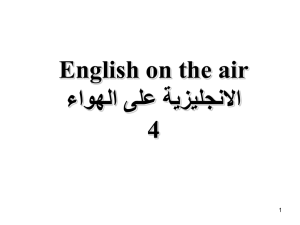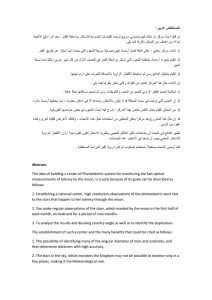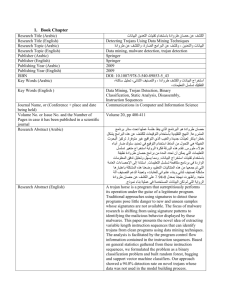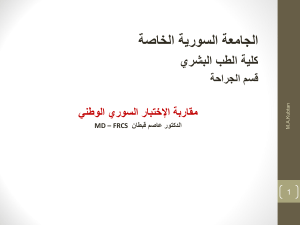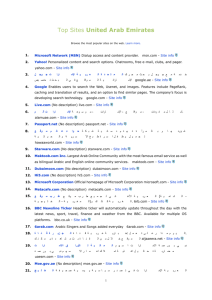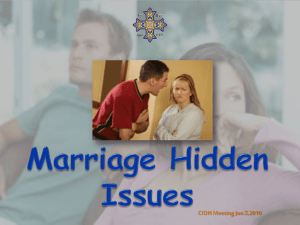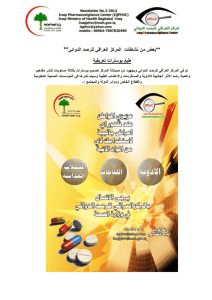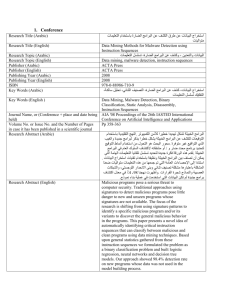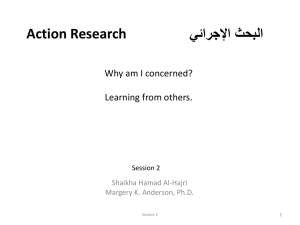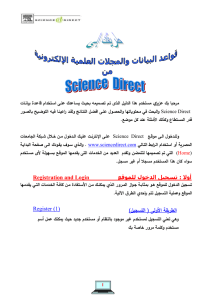LANGUAGE AND THOUGHT PROCESSES
advertisement
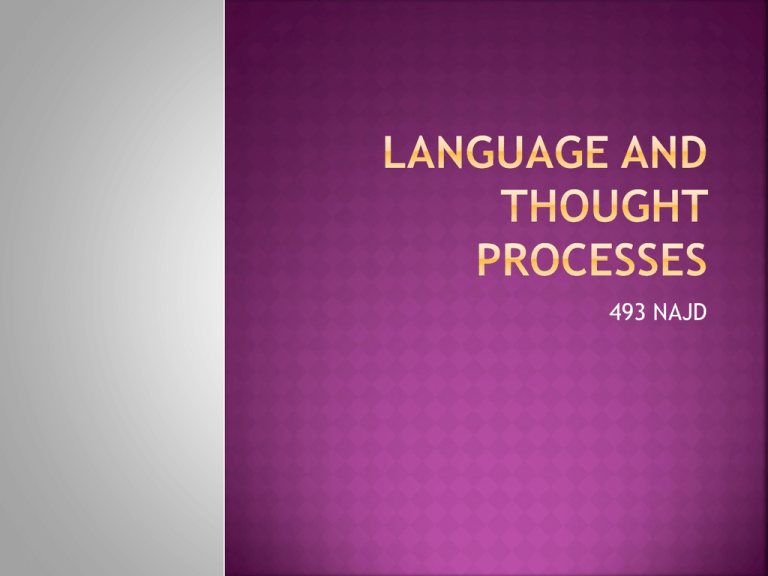
493 NAJD Language is more than just a means of communication. It influences our culture and even our thought processes. During the first four decades of the 20th century, language was viewed by American linguists and anthropologists as being more important than it actually is in shaping our perception of reality. This was mostly due to Edward Sapir and his student Benjamin Whorf who said that language predetermines what we see in the world around us. You → Your language → “reality” Cross cultural comparisons of such things as color terms were used by Sapir and Whorf as evidence to prove their point. When we perceive color with our eyes, we are sensing that portion of electromagnetic radiation that is visible light. In fact, the spectrum of visible light is a continuum of light waves with frequencies that increase at a continuous rate from one end to the other. In other words, there are no distinct colors like red and green in nature. Our culture, through language, guides us in seeing the spectrum in terms of the arbitrarily established categories that we call colors. Different cultures may divide up the spectrum in different ways. This can be seen in the comparison of some English language colors with their counterparts in the Tiv language of Nigeria (page 9) High value = light Low value = dark Sapir and Whorf interpreted these data as indicating that colors are not objective, naturally determined segments of reality. In other words, the colors we see are predetermined by what our culture prepares us to see. (clip) This example used to support the Sapir-Whorf hypothesis was objectively tested in the 1960's. That research indicated that they went too far. All normal humans share similar sense perceptions of color despite differences in color terminology from one language to another. The physiology of our eyes is essentially the same. People all over the world can see subtle gradations of color and can comprehend other ways of dividing up the spectrum of visible light. Clip: How we see color However, as a society's economy and technology increase in complexity, the number of color terms usually also increases. That is to say, the spectrum of visible light gets subdivided into more categories. As the environment changes, culture and language typically respond by creating new terminology to describe it. It is now clear that the terminology used by a culture primarily reflects that culture's interests and concerns. For instance, Indians in Canada's Northwest Territories typically have at least 13 terms for different types and conditions of snow, while most non-skiing native Southern Californians use only 2 terms--ice and snow. That does not mean that the English language only has 2 terms. Quite the contrary, there are many more English words that refer to different states of frozen water, such as blizzard, dusting, flurry, frost, hail, hardpack, powder, sleet, slush, and snowflake. The point is that these terms are rarely if ever used by people living in tropical or subtropical regions because they rarely encounter frozen water in any form other than ice cubes. The distinctions between different snow conditions are not relevant to everyday life and children may not even have the words explained to them. However, people in warmer regions make fine distinctions about other phenomena that are important to them. For instance, coastal Southern Californians often have dozens of surfing related words that would likely be unknown to most Indians in the Northwest Territories or to people living in Britain for that matter. The The Arabs’ view of ‘winds’ Arabs’ view of ‘winds’ – especially in the Arabian Peninsulais another example showing that the terminology used by a culture mainly reflects that culture's interests and concerns. Arabic typically has more than 30 terms for different types and conditions of wind and they are as follows: ال َ قيم :التي ال تقلع الشجر وال تحمل المطر. ع ِ ال ُ حة :التي ته ّ و َ ب من جهات مختلفة. م َت َنا ِ النافخة :الريح التي تبدأ بش ّ دة . ال َن ْ كباء :الريح التي وقعت بين ريحين. جاج وال َ ه ْب َ م ْع َ وة :التي تثير الغبار. ال ِ ه ُ ال َ جوم :الشديدة التي تقتلع الخيام. جاء :الحارة التي ته ّ ه ْيف وال َ ال َ ه ْو َ ب من جهة اليمين. َّ َّ َّ الش ْ مال :التي ته ّ والش َ والش َ ب من نقطة مل مل الشمال. مالح :التي تجري بها السفينة وبه س ِ ّ مي المالَّح ال ِ َّ ً مالحا . دة :الريح الهوجاء التي تذهب بك ِ ّ َرا َ ل االتجاهات. َّ َّ َّ َّ َّ والس ْي َ والس ْي َ ه َ والس ْي ُهوج : والس ُهوج جة هج السينهوج الريح الشديدة. والز ْ والز ْ الز ْ َّ َّ َّ ع َز َ عان :التي تحرّك أغصان ع َزع عزاع الشجر بش ّ دة وتقتلع األشجار. البَليل :الريح الباردة ذات الندى. والن ُ َّ َّ ؤوج :الريح السريعة ال َ ال َ مرّ. والد ُروج ملة جا ِ جنوب :التي ته ّ ال َ ب من نقطة الجنوب. ح ْ صبَاء وال َ صبة وال َ صب :التي تجيء بالحصباء. حا ِ الحا ِ والح ْر ُ ُ ح ْر َ ال َ جوج :الريح الباردة الشديدة. جف ال َ حرور والبَا ِرح :الريح الحارة. ال َ م ْه َداج :التي لها حنين"صوت". حنون وال ِ ال َ خريق :الشديدة البرد تخترق الثياب. َّ الس ْ ج َ سج و َر ْي َدة و َر ْي َدانَة :اللينة المعتدلة. َّ الراعفة :الشديدة المطر. َّ السموم :الريح الحارة. َّ َّ الس ْ م َ الس ْهلَة. هج :الريح َّ الصبَا :التي ته ّ ب من نقطة الشرق. َّ صر والخا ِزم وال َ الص ْر َ ريَّة :الريح الباردة. ع ِ َّ َّ صف وال َ والن ْو َرج :الريح الشديدة. والن ْي َرج هيَج العا ِ ّ تلقح الشجر. اللواقِح :التي Types of British Rain: Mist Mizzle Drizzle Spitting Spotting Rain Showers Downpour Torrential Sleet, etc. The number of terms related to a particular topic also may be greater or smaller depending on such social factors as gender. For example, North American women generally make far more color distinctions than do men. This may be largely due to the fact that subtle color differences are important factors in women's clothing and makeup. Parents and peers usually encourage and train girls early to be knowledgeable about these distinctions. The cultural environment that people grow up in can have surprising effects on how they interpret the world around them. This became apparent during a Washington D.C. murder trial in 2002. A deaf man was convicted of stabbing to death two of his classmates at Gallaudet University. At his trial, the defendant said that he was told to do it by mysterious blackgloved hands. His delusions did not come in the form of spoken language. He was told to commit these brutal murders through sign language--his mode of communication. Another example is provided by Guugu Timithirr language speakers of the Cape York Peninsula in northeastern Australia. This group of Aborigines do not have words for left, right, front, or back. They use absolute rather than relative directions. When they refer to people or objects in their environment, they use compass directions. They would say "I am standing southwest of my sister" rather than "I am standing to the left of my sister." Critics of the Sapir-Whorf hypothesis would point out that the Aborigines who speak this language also usually learn English and can use left, right, front, and back just as we do. Ethnoscience Anthropologists have found that learning about how people categorize things in their environment provides important insights into the interests, concerns, and values of their culture. Field workers involved in this type of research refer to it as ethnoscience. Etic categories involve a classification according to some external system of analysis brought in by the visitor (from another culture. This, for example, is the approach of biology in using the Linnaean classification system to define new species. It assumes that ultimately, there is an objective reality and that is more important than cultural perceptions of it. In contrast, emic categories involve a classification according to the way in which members of a society classify their own world. It may tell us little about the objective reality but it is very insightful in understanding how other people perceive that reality through the filter of their language and culture.
